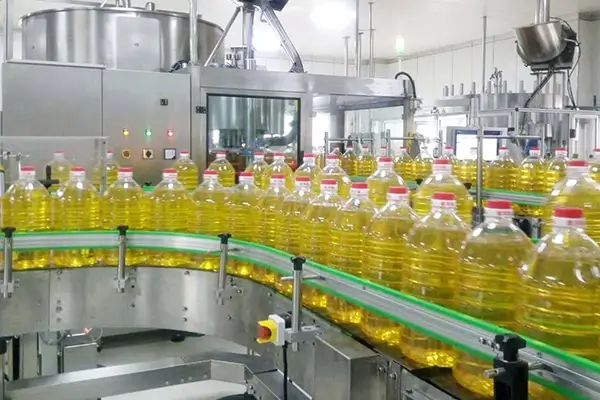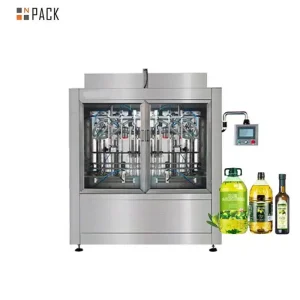The edible oil filling machine production line from bottle preparation to labeling and packaging has different filling methods to improve production efficiency.
Our edible oil industry, a necessity for our national life, is still experiencing steady growth due to factors such as economic growth and residents’ increased consumption. This makes many entrepreneurs want to open an edible oil packaging factory, and the edible oil filling production line is necessary equipment for packaging edible oil. But there are many edible oil filling machine production lines; how to configure them has become a problem that confuses the oil factory owner.Let the edible oil filling machine manufacturer introduce it in detail!
Edible Oil Filling Machine Production Line
The edible oil filling machine production line can be roughly divided into three sections. Preliminary preparation, mid-term packaging, and late transportation.

Preliminary preparation
- The first stage is the oil press, which mainly processes peanuts, soybeans, sesame, rapeseed and other oil raw materials into oil! The main equipment in this stage is the oil press. After the oil is ready, the second stage is next.
The Filling Process of Edible Oil
- The second stage is the bottle blowing machine-air bottle washing machine-filling machine-light inspection-covering-capping-pressing-lifting ring-inking-labeling and other equipment. This stage is mainly the oil packaging stage. The main equipment used is as follows:
1.Bottle blowing machine and air bottle washing machine
They are mainly for preparation before filling, and clean oil bottles and barrels are prepared.
2.Edible oil filling machine:
The filling equipment is categorized into micro, small, medium, and large package edible oil filling machines based on the various types of bottles and barrels utilized by consumers.
According to the filling method, it is divided into weighing type and flow type. Filling form: linear type and rotary type.
According to the filling capacity, generally 1L or less is micro packaging, generally 500ml or more-5L and below are small packaging, 10L and above are medium packaging, and standard barrels of about 180 kg are generally called large packaging. Different specifications of products have corresponding filling equipment and solutions. The filling machine sets the operating specifications with one button, which is simple to operate and stable in operation.
Fully automatic edible oil filling machine also has many advantages:
The filling head design and vacuum suction system of the fully automatic edible oil filling machine ensure that there is no residual oil dripping during the filling process. It not only ensures the safety of edible oil products, but also effectively saves raw materials for enterprise production.
The fully automatic edible oil filling machine adopts fast and slow dual-speed filling, and the filling speed is adjustable to prevent overflow. It improves the production environment of edible oil products and enhances the overall market image of edible oil products.
The fully automatic edible oil filling machine adopts power filling, and does not need to be equipped with high-level tanks. It simplifies the installation process and improves the filling efficiency. It is convenient for enterprises to operate and opens up a new shortcut for enterprise development.
The fully automatic edible oil filling machine is equipped with a crawler capping machine. Stable and noiseless, no air pressure phenomenon.
The touch screen interface of the fully automatic edible oil filling machine is friendly and easy to operate. The Siemens PLC control system has fast computing speed and stable performance.
3.Cap sorting and capping machine
It has the function of automatic cap sorting and capping to reduce labor intensity.
4.Automatic ring pressing machine
It can save labor costs and improve efficiency.
5.inkjet printer
An inkjet printer is a device that produces product labels, including manufacturing dates, typically utilizing two methods: inkjet printing and laser printing.
Inkjet Printing: The choice of inkjet solution generally uses a water-based inkjet solution, a dye ink solution or a pigment ink solution, which is matched according to the needs of the label application. Dye inks are used on paper labels with bright colors and low cost, but at the same time, dye inks have the disadvantage of poor light and water resistance, so they are mainly used on some fast-circulating paper type labels that do not require high light and water resistance. Pigment inks have good light, water and friction resistance when used on paper labels because the ink coloring material is a pigment and the system contains resin. The color brightness can also meet customer needs, and it has become the mainstream solution for paper type labels.
Laser Printing: Laser printers print by heating and fixing toner on paper. Its biggest feature is that it is durable and prints quickly, and even later maintenance is very worry-free.
Labeling machines are also critical in edible oil filling production lines. It can allow customers to understand the product more intuitively. The precise list of ingredients and production date make customers more confident about the product. There are generally two forms of labeling for edible oil: single-sided labeling and double-sided labeling. The most commonly used labeling method is the self-adhesive labeling machine. There is also a cold glue labeling machine, which is not widely used.
Self-adhesive labeling: Self-adhesive labels are also called self-adhesive labels, instant stickers, instant stickers, pressure-sensitive paper, etc. They are a composite material with paper, film or special materials as the surface, adhesive on the back, and silicone-coated protective paper as the base paper. After printing, die-cutting and other processing, they become finished labels. When applied, just peel it off from the base paper and press it lightly to stick it on the surface of various substrates. You can also use a labeling machine to automatically label on the production line.
Cold glue labeling: This method uses cold glue to attach the labels to the bottle, often employed for more traditional or specific packaging requirements.
Unpacking and Sealing Production
- The third stage is the unpacking and sealing production line, palletizing and conveying equipment, this stage is mainly to transport and convey edible oil. Introduction to the leading equipment in this stage:
Unpacking and sealing production line: automatic unpacking and bottom sealing-automatic packing-automatic sealing functions (standard packing methods are drop-type and grab-type packing methods) save labor and increase packaging production.
Palletizing and conveying equipment: The conveyor line can be customized as needed, and the palletizing is automatically palletized by the palletizing robot, which is efficient, fast and safe.
According to the specific requirements of the customer’s floor, bottle type, filling range, etc., the following equipment can also be selected: bottle clamping conveyor line, screw conveyor, vertical flap conveyor, vertical automatic box drop machine, automatic capping machine, capping machine, rubber cap shrinking machine, large character inkjet printer, heat shrink packaging machine, weight detection machine and other related equipment.
The above are the equipment in the edible oil filling production line. The edible oil factory can freely configure it according to the plant area, production needs, and future development.
